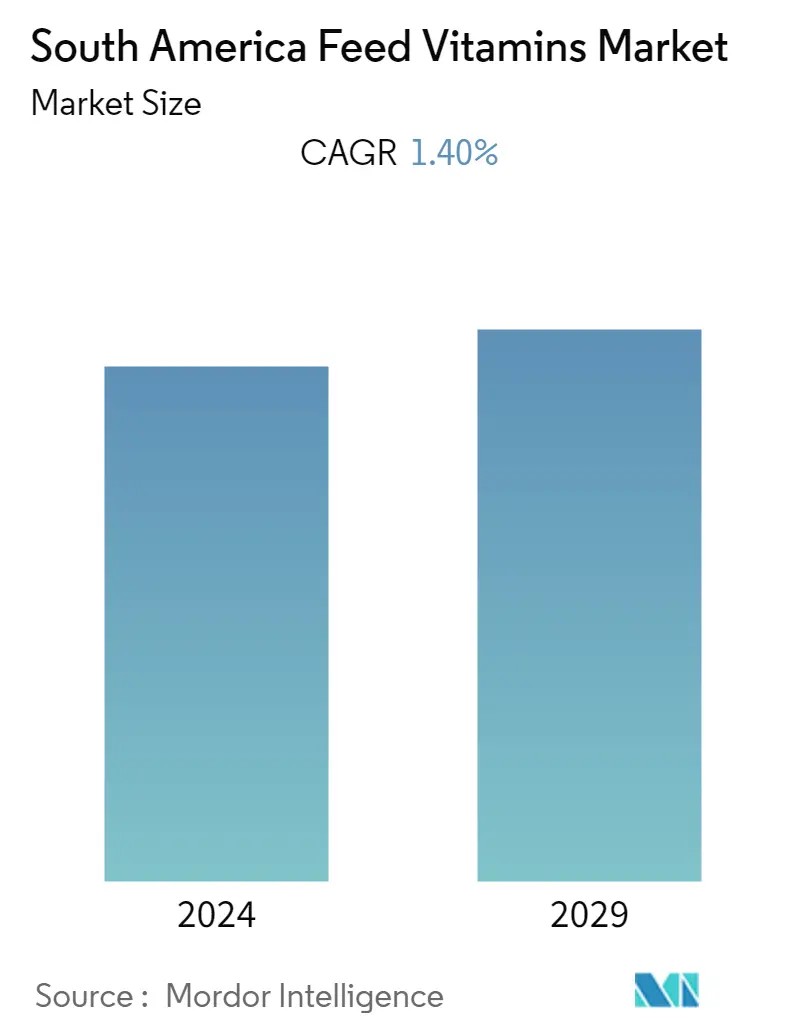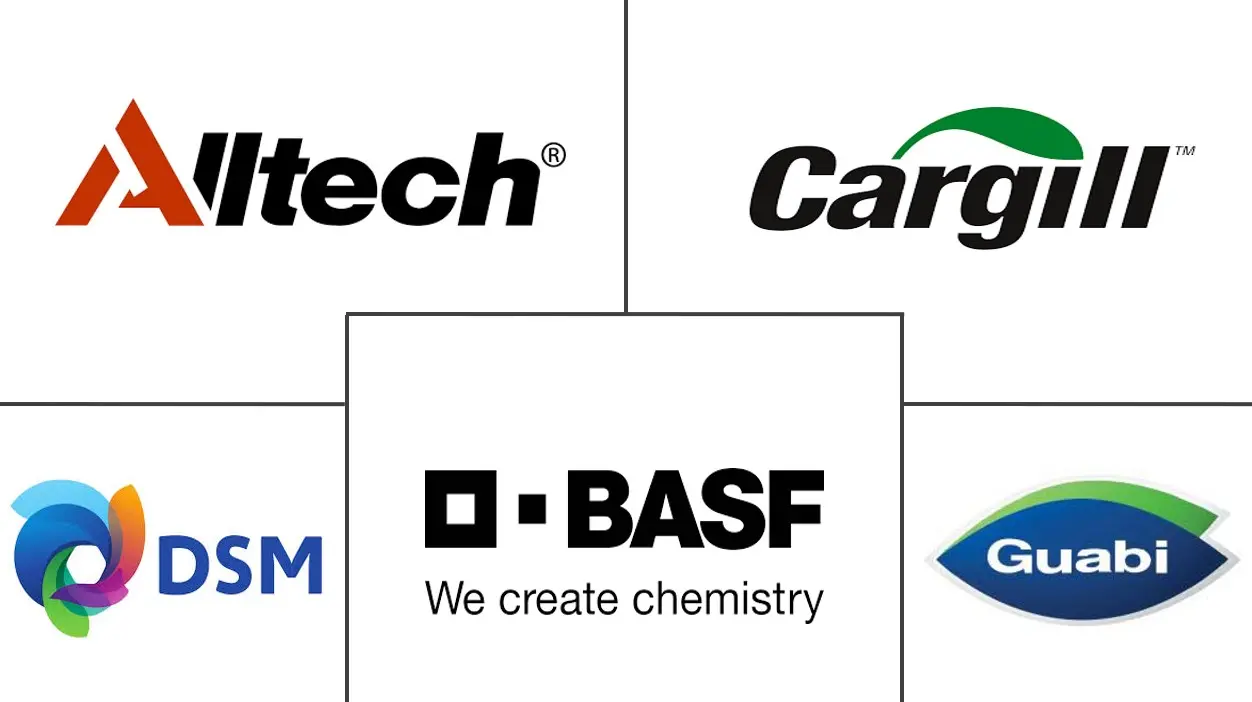Market Size of South America Feed Vitamins Industry

| Study Period | 2019 - 2029 |
| Base Year For Estimation | 2023 |
| Forecast Data Period | 2024 - 2029 |
| Historical Data Period | 2019 - 2022 |
| CAGR | 1.40 % |
Major Players
*Disclaimer: Major Players sorted in no particular order |
South America Feed Vitamins Market Analysis
The South American feed vitamin market is projected to register a CAGR of 1.4% over the forecast period. Some of the factors driving the market such as industrialization of the livestock industry, expansion of animal meat market, and livestock disease outbreak fuelling additives market. Brazil dominates the market due to the rising livestock population and meat consumption. The feed vitamin market is projected to grow along with the increased feed production, growing animal health concern, and ban on antibiotics use. Companies like Alltech Inc., BASF SE, DSM Nutritional Products AG, and Archer Daniels Midland Co. Guabi Nutrição e Saúde Animal SA, are the major players in the studied market. In March 2020, De Heus has acquired Cerrado Nutrição Animal, a Brazilian cattle nutrition company, having a manufacturing capacity of 50,000 tons a year with a strong presence in the country. This would increase De Heus' production capacity and strengthen the presence.
South America Feed Vitamins Industry Segmentation
Vitamins are supplements included in the animal feeds in small amounts for the overall growth, well-being and performance of the livestock. Deficiency of vitamins can be adverse to the health of the animals and will also lead to a wide range of diseases. Vitamin supplements are considered necessary in animal feeds for all kinds of livestock, and this has traditionally fuelled the animal feed vitamin market. An increase in the demand for quality meat, developing markets, health concerns & disease outbreak in livestock have driven the growth of the market. The scope of this report is limited to vitamins supplied to animals in the form of feed additives and vitamins supplied externally, in the form of premixes are not part of the report scope.
| Type | |
| Vitamin A | |
| Vitamin B | |
| Vitamin C | |
| Vitamin E | |
| Other Vitamins |
| Animal Type | |
| Ruminants | |
| Poultry | |
| Swine | |
| Aquaculture | |
| Other Animal Types |
| Geography | |
| Brazil | |
| Argentina | |
| Rest of South America |
South America Feed Vitamins Market Size Summary
The South American feed vitamins market is experiencing growth driven by factors such as the industrialization of the livestock industry, the expansion of the animal meat market, and the need for additives due to livestock disease outbreaks. Brazil plays a dominant role in this market, largely due to its increasing livestock population and meat consumption. The market is expected to expand alongside the rise in feed production, heightened animal health concerns, and the ban on antibiotic use. Key players in the market include Alltech Inc., BASF SE, DSM Nutritional Products AG, and Archer Daniels Midland Co. The acquisition of Cerrado Nutrição Animal by De Heus in 2020 exemplifies strategic moves to enhance production capacity and market presence in Brazil.
Vitamins are essential for normal body functions, growth, and reproduction in animals, and their inclusion in feed is crucial to overcoming deficiencies that can impact productivity, such as reduced egg production in hens due to vitamin A deficiency. The growing animal population and increasing compound feed production in countries like Brazil and Argentina are significant drivers of the vitamins market. The shift towards commercial livestock production, particularly in poultry, and the prohibition of certain antibiotics in swine production in Brazil have further propelled the demand for vitamin additives. Companies in the region are focusing on strategic investments, product development, and collaborations to strengthen their market positions and enhance research and development activities.
South America Feed Vitamins Market Size - Table of Contents
-
1. MARKET DYNAMICS
-
1.1 Market Overview
-
1.2 Market Drivers
-
1.3 Market Restraints
-
1.4 Porter's Five Force Analysis
-
1.4.1 Bargaining Power of Suppliers
-
1.4.2 Bargaining Power of Buyers/Consumers
-
1.4.3 Threat of New Entrants
-
1.4.4 Threat of Substitute Products
-
1.4.5 Intensity of Competitive Rivalry
-
-
-
2. MARKET SEGMENTATION
-
2.1 Type
-
2.1.1 Vitamin A
-
2.1.2 Vitamin B
-
2.1.3 Vitamin C
-
2.1.4 Vitamin E
-
2.1.5 Other Vitamins
-
-
2.2 Animal Type
-
2.2.1 Ruminants
-
2.2.2 Poultry
-
2.2.3 Swine
-
2.2.4 Aquaculture
-
2.2.5 Other Animal Types
-
-
2.3 Geography
-
2.3.1 Brazil
-
2.3.2 Argentina
-
2.3.3 Rest of South America
-
-
South America Feed Vitamins Market Size FAQs
What is the current South America Feed Vitamins Market size?
The South America Feed Vitamins Market is projected to register a CAGR of 1.40% during the forecast period (2024-2029)
Who are the key players in South America Feed Vitamins Market?
DSM Nutritional Products AG, BASF SE, Alltech Inc., Guabi Nutrição e Saúde Animal SA and Cargill, Incorporated are the major companies operating in the South America Feed Vitamins Market.

